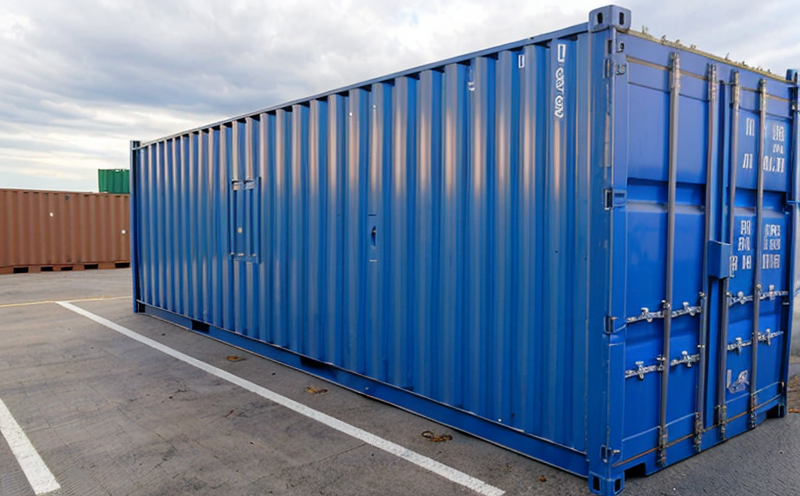ISTA 1A Transport Testing of Plastic Storage Containers
The ISTA 1A transport test is a critical standard in the plastics industry designed to simulate real-world conditions that plastic storage containers might encounter during transportation. This test assesses the durability, resilience, and integrity of packaging under dynamic conditions such as impact, vibration, and temperature fluctuations.
Plastic storage containers are widely used across various sectors including logistics, manufacturing, retail, and distribution due to their cost-effectiveness, light weight, and flexibility in design. However, these advantages come with the need for robust testing to ensure they can withstand the rigors of transport without compromising on safety or performance.
The ISTA 1A test method focuses primarily on simulating a worst-case scenario during transportation. It includes tests such as drop tests from various heights onto different surfaces and vibration tests that mimic road conditions. Compliance with this standard ensures that plastic storage containers meet international quality and safety benchmarks, thereby enhancing customer confidence in your products.
The test procedure involves conditioning the containers to specific temperature and humidity levels before subjecting them to a series of impacts using standardized weights. Each impact is carefully recorded for analysis purposes. This process helps manufacturers identify potential weaknesses early on so they can make necessary adjustments to improve product performance.
Understanding the importance of this testing lies in its ability to predict how products will behave under harsh environmental conditions, ensuring reliability and safety throughout their lifecycle. By adhering to ISTA 1A standards, companies not only meet regulatory requirements but also gain competitive advantages by delivering superior quality goods that are trusted by consumers worldwide.
For effective implementation of ISTA 1A transport testing, it's essential to follow all prescribed procedures meticulously. This includes proper specimen preparation, selecting appropriate equipment, and interpreting results accurately. A well-executed test provides valuable insights into the performance characteristics of plastic storage containers, enabling informed decisions about design improvements or material selection.
In conclusion, ISTA 1A transport testing plays a crucial role in enhancing the quality and safety of plastic storage containers used across diverse industries. Its rigorous approach ensures that these containers can endure challenging transportation environments without compromising on functionality or integrity. Companies investing time and resources into this type of testing demonstrate their commitment to excellence, ultimately contributing to increased customer satisfaction and brand reputation.
Why It Matters
The ISTA 1A transport test is pivotal for several reasons:
- Enhanced Product Quality: By simulating actual transport conditions, this test helps identify potential flaws early in the manufacturing process.
- Improved Safety Standards: Compliance with international standards like ISTA ensures that products meet stringent safety regulations globally.
- Increased Customer Trust: Demonstrating adherence to recognized testing protocols builds confidence among end-users regarding product quality and reliability.
- Competitive Advantage: Superior performance in such tests can set your company apart from competitors, attracting more business opportunities.
The results of ISTA 1A transport testing serve as a benchmark for evaluating the robustness of plastic storage containers. They provide valuable data that can be used to refine designs and enhance material choices, leading to better overall product performance.
Why Choose This Test
Choosing ISTA 1A transport testing offers numerous benefits:
Comprehensive Coverage: The test covers multiple aspects of packaging behavior under dynamic conditions. It evaluates physical properties like impact resistance, crush strength, and puncture resistance.
Regulatory Compliance: Adherence to this standard ensures that your products meet international regulatory requirements, facilitating smoother operations across borders.
Risk Mitigation: By identifying potential issues early on through rigorous testing, you minimize risks associated with product failure during transport.
Better Decision Making: Accurate test results provide crucial information about the performance of your products. This data supports informed decision-making when optimizing designs or selecting materials.
In summary, ISTA 1A transport testing is an indispensable tool for quality assurance in the plastics industry. It provides comprehensive evaluation capabilities while ensuring regulatory compliance and minimizing risks associated with product failure.
Competitive Advantage and Market Impact
- Better Product Performance: Meeting ISTA 1A standards sets a benchmark for superior packaging solutions that outperform competitors in terms of reliability and safety.
- Premium Brand Image: Demonstrating commitment to quality through rigorous testing enhances brand reputation among consumers who prioritize product integrity.
- Increased Customer Satisfaction: Products that pass ISTA 1A tests are perceived as higher quality, leading to greater customer loyalty and repeat business.
- Growth Opportunities: Adherence to international standards opens doors to new markets where compliance with such protocols is mandatory for entry into specific countries or regions.
In conclusion, ISTA 1A transport testing provides significant competitive advantages by ensuring product quality meets the highest standards. This not only benefits individual companies but also contributes positively towards overall industry growth and consumer trust.





